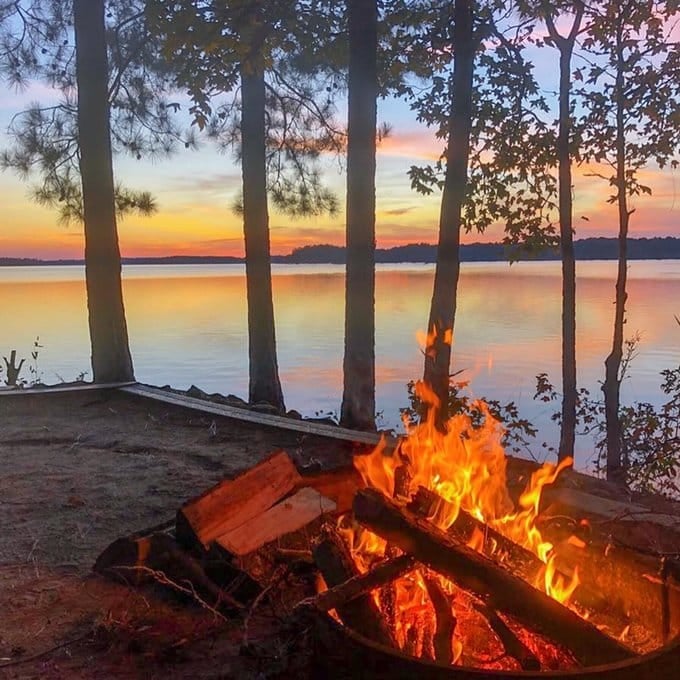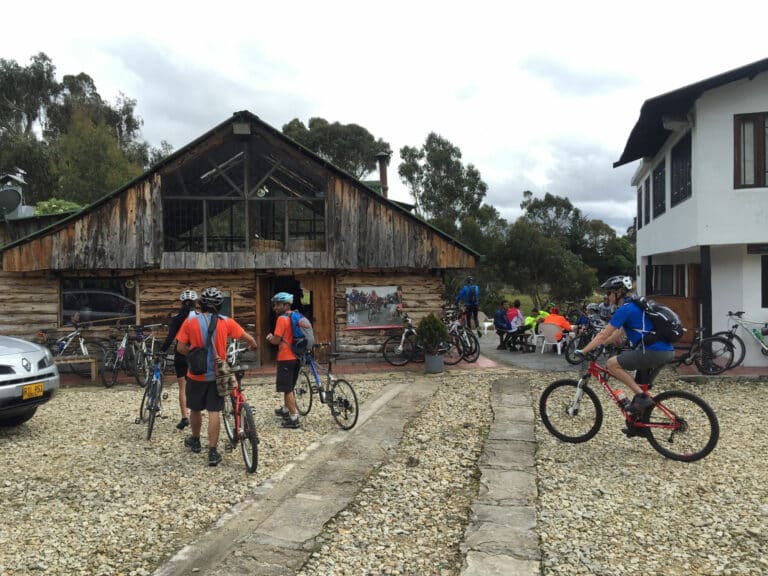As I pushed off in my kayak into the cool waters of the Nantahala River, I felt surprisingly nervous. I swiveled my hips. Practiced a few paddle strokes and braces. Other than feeling rusty, it was a perfect day on the river. A hot summer sun pierced the overhanging foliage. My wife and friends were paddling a raft behind me.
I’d kayaked this section more times than I could remember, but I hadn’t been here for several years. In fact, due to a lengthy family crisis, I hadn’t boated much whitewater at all during that time. When my mom became ill, she needed me with her. So I pressed pause on activities like whitewater paddling, bikepacking, and skiing. We moved her in with us, and I focused on mellower activities closer to home. When she sadly had to go to assisted living, and later passed away, I found it harder to press play than I expected.
Not only was I out of practice, I felt distracted too. My conditioning, my timing, my focus—everything was off. So I planned a reunion at an old stomping ground. A great class II+ river with a single III at the end. After today’s eight-mile warm-up, I’d spend a few days at the Nantahala Outdoor Center shadowing a beginner class, sitting in with an intermediate group, and working with a private instructor. The goal was to get back to basics. To rebuild confidence and skills.
“I forgot how tippy this thing is,” I said, snapping the edges of my boat.
“Yeah, no kidding,” said my buddy Boberts, who was guiding the raft. It had been a while for him too, so he practiced a few paddle strokes with the crew.
Floating downstream, I spotted an eddy in the middle of a minor rapid. I tried to forget about the jitters by whipping behind the rock, spinning around, dropping my blade into current, and peeling out behind the raft. It was a minor move but reminding myself I could do it felt huge.
The day went great. Each rapid felt better than the last. Along the way, we lounged in eddies and waved to the friendly folks floating past. My biggest challenge came at Surfer’s Rapid, where it took 10 tries to get a ride. By the time we plunged through the hole at Nantahala Falls, we were tired but confident. Things were slowly coming back, and hopefully the next few days at NOC would accelerate the trend.

Beginner Skills: Basic Paddling & T-Rescues
Come Monday morning, I hopped in an NOC van with a beginner class. The paddling school typically caps enrollment at four students per class, but this week was quiet. Just the instructor Blue, two students, and me. Everyone hit it off, and we spent a short drive chatting and joking.
At Fontana Lake, the morning lesson progressed quickly to wet exits, where you pull off your spray-skirt and swim out of the boat. A crucial first skill. Next, we practiced basic paddle strokes on land and water. Then came angle control, edging, and turning.
Another morning focus was T-rescues, a helpful technique for beginners ready to paddle mellow waters without a roll. Basically, one paddler holds their breath, flips upside down, and runs their hands along the hull. On the surface, a second kayaker propels the nose of their boat against the inverted hull. The upside-down paddler grabs the rescuer’s bow loop, drops their head to their hands, and hip snaps themselves upright. Later, should the beginner flip over in current, a T-rescue can get them upright without a swim.
While Blue helped one student, the other asked if he could try a roll with me. Just like when I learned, his first attempts were not pretty. The paddle blade dove sideways underwater, and he thrashed about before signaling for a T-rescue. No shame there. Learning this sport takes time. Next it was my turn, and I felt unsure after a long break. I flipped over and set up. Swept my blade and snapped my hips. I did roll up, but the ending felt off. Somewhat choppy and delayed. Something to work on later in the week.

That afternoon, the class moved to the Little Tennessee River. The students began putting together the various techniques—edging, paddling, turning—as they navigated easy class II riffles.
“If you don’t want to hit the rocks, don’t look at them,” instructed Blue.
Tomorrow, the beginning class would mix some lake hours with easy class II sections on the Nanty. I’d check back in with them later in the week after joining an intermediate group.
Intermediate Skills: Efficient Paddling and Picking Lines
“I put the student out in front,” explained instructor Dan Dixon. “They lead me down the river, and I let them get into anything I can get them out of.”
Three of us were kayaking down Section 9 of the French Broad River, eddy hopping and joking along the way. Going first was Jean Marc, a paddler from Mexico City, who’s been coming to NOC for five summers to work with Dan. After decades of cenote diving, sailing, and car racing, an accident forced Jean Marc to have several vertebrae fused. So he sought his favorite teacher’s guidance to adapt his paddling. Dan is an NOC master instructor who has been with the company for 40 years. He’s also a famous expedition kayaker, codename “Greystoke,” who has paddled all over the world.

Unlike the Nanty, there’s no upstream dam releasing water on this river. A recent bump from rain meant this class III section was low but running. Still, Dan’s philosophy is to get the most from whatever level encountered. Spotting some deep current with several mid-river rocks, he called us over for an exercise. From the top of the eddy, we paddled below one rock, looped around another, and returned in the fewest strokes possible. After 30 minutes, each of us had reduced our total strokes by half.
“When people think they can’t make an eddy, they give up,” explained Dan. “A lot of times, there’s more opportunities to make it.”
We spent the rest of the day taking our time on the four miles from Barnard to Stackhouse. In many spots, huge fins of bedrock rose above our helmets. Our goal was to find creative paths down the rocky river, what paddlers call lines through the rapids.
Advanced Skills: Perfecting Techniques
For my final day at NOC, I worked one-on-one with Dan. We started at Fontana Lake, where I asked for help correcting some bad habits. While I’m not exactly a self-taught kayaker, I learned as a young raft guide from many friends made on the river. Some of my habits come from starting in rafts before jumping into kayaks. I’m good at reading water, picking a line, and navigating through rapids. But occasionally I throw in a quick rudder stroke to change angles or to lose speed. I’m not always the most instinctive or efficient paddler.
Quickly, Dan had me working on full body paddle strokes. Holding my paddle shaft vertical more often and placing my stroke right next to the boat. Driving the blade underneath the hull to turn even more efficiently toward the same side as that stroke. I’d long ago learned how to use a flare, or draw stroke, to turn toward the side I place the paddle. Dan helped me clean up the mechanics of my draw. This allowed me to better continue into a vertical forward stroke, leading to a more fluid and efficient movement.
When I demonstrated my rusty roll, Dan instantly identified the reason behind the ending wobble that had appeared after my kayaking hiatus.
“You don’t weigh your butt cheeks evenly,” he diagnosed.
“I have imbalanced butt cheeks,” I pondered.

Dan was right. I have an old back injury that comes and goes. This causes me to sometimes favor my right side compared to the left. Over the years, I occasionally found my off-side roll worked better than my onside. When I was kayaking more regularly, I must have corrected this instinctively. In the intervening years, I’d resumed the old habit of favoring the right.
“Stomp your butt cheek into the seat,” said Dan.
I flipped over and rolled back up, adding a right-cheek stomp. My boat fixed itself upright with a click.
“Woah,” I said. “That felt way better.”
We spent the afternoon back at the Nanty, where I bumped into Blue’s beginner group. The students had progressed impressively to day three of the four-day course. Already they were leading the way through the tougher rapids. After a friendly hello, it was time for each of us to get back to work.
Dan talked me through a sequence for putting together the new techniques. We eddied out in the middle of rapids, ferried through fast current, and worked on catching eddies in different ways. One method involved throwing a blocking stroke into the top of an eddy to swiftly change directions and stop behind the rock. We also practiced attainments, aka paddling up the rapids, before circling back downstream and doing it again.
When we reached class III Nantahala Falls, Dan challenged me to run the rapid in a way I’d never considered. Usually, on my past friend trips, we were gunning downstream for some fun at NOC’s riverside bar. This time, I took a right-side line with a boof off a partially exposed rock. After landing in the frothing eddy, it was all smiles.
Cover photo: The author at Surfers Rapid. Photo by Boberts.








